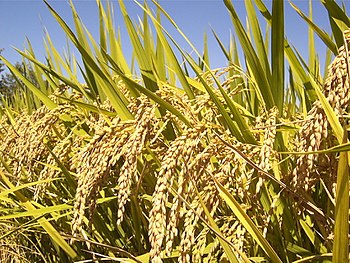| Mature rice panicle against blue sky. Part of the image collection of the International Rice Research Institute (IRRI) . (Photo credit: Wikipedia) |
When Harsh Bais grows rice plants in trays of water in his greenhouse at the University of Delaware, he can easily spot the ones that have been exposed to arsenic: They are stunted, with shorter stems and shrunken leaves.
Dr. Bais is working to develop rice plants that take up less arsenic, a common contaminant in the fields of his native India and other Asian countries. Chronic exposure to arsenic has been linked to heart disease, diabetes and genetic damage associated with elevated risks for cancer.
But instead of trying to breed new strains of rice or alter its DNA, he and other scientists are looking at the vast microbial community that lives near the rice’s roots.
These bacteria are the botanic equivalent of the human microbiome – the trillions of organisms that live in our guts, many performing beneficial tasks like digesting food and fighting off infection.
The hope is to find bacteria that will somehow block arsenic. In the past three years, Dr. Bais has isolated about a dozen bacterial species, added them to plants and looked for signs of arsenic poisoning.
Now, he says, he has zeroed in on one species, Pantoea agglomerans, that seems to reduce arsenic in the stem to one-eighth its former levels.
“Research on the plant microbiome is very hot because everyone is trying to find things that can increase growth and yield,” said Dr. Bais, an associate professor at Delaware.
For scientists interested in tweaking plant traits, there is a list longer than ever of bacteria to investigate. Advances in DNA sequencing have made it possible to identify large groups of related bacteria from different plant types and soil conditions.
Agricultural companies are already using bacteria on seeds of major crops such as corn and soybeans to help them bear more fruit or require less fertilizer. This year, Monsanto entered a partnership with Novozymes, a Danish company that sells more than 200 biologic products, to test organisms from the corn and soybean microbiomes at thousands of field sites.
A study of the rice microbiome is underway in the lab of Venkatesan Sundaresan, at the University of California, Davis. Using DNA sequencing, he has found at least a quarter-million bacterial species in the rice microbiome.
Dr. Sundaresan is also interested in the functions of individual microbes. So he is collaborating with Dr. Bais, shipping him soil from rice roots in his test field in Davis.
P. agglomerans is the first microbe that has been shown to reduce arsenic in rice. While the microbe appears to keep most arsenic out of the rice’s stem and leaves, the crucial question is how it affects the grain.
“Microbes for crops have the reputation of being finicky.” said Tom Adams, vice president for chemistry technology at Monsanto. But he added that new technology could help predict which microbes would work best in different soil and environmental conditions.
Taken from TODAY Saturday Edition, The New York Times International Weekly, September 27, 2014











No comments:
Post a Comment